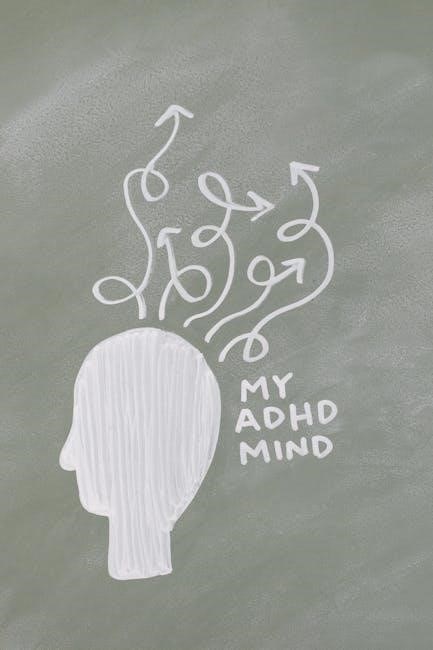The Brief Cognitive Rating Scale (BCRS) is an objective measure aligning with the Global Deterioration Scale (GDS) to assess cognitive decline across five key domains.
1.1 Definition and Purpose
The Brief Cognitive Rating Scale (BCRS) is a standardized tool designed to assess cognitive impairment across five key domains: concentration, recent memory, past memory, orientation, and functioning. It aligns with the Global Deterioration Scale (GDS) to stage cognitive decline objectively. The primary purpose of the BCRS is to provide a concise yet comprehensive evaluation of cognitive status, aiding clinicians in early detection and monitoring of impairment. It is particularly useful in identifying stages of dementia and guiding clinical decision-making. The scale ensures consistency and reliability in assessing cognitive function, making it a valuable resource for healthcare professionals.
1.2 Importance of Cognitive Assessment
Cognitive assessment is crucial for early detection and management of impairments, ensuring timely interventions. Tools like the Brief Cognitive Rating Scale (BCRS) play a vital role in identifying cognitive decline stages, enabling personalized care plans. Early identification helps in slowing progression and improving quality of life. The BCRS, alongside the Global Deterioration Scale (GDS), provides a structured framework for monitoring changes over time. This leads to better patient outcomes and more effective resource allocation in healthcare settings. Accurate cognitive evaluation is essential for addressing the complex needs of individuals with cognitive impairments, making scales like the BCRS indispensable in clinical practice.

Structure and Components of the BCRS
The BCRS consists of five axes: concentration, recent memory, past memory, orientation, and functioning. It is designed to assess cognitive decline in a structured manner, aligning with the Global Deterioration Scale (GDS) for comprehensive evaluation.
2.1 Overview of the Five Axes
The BCRS evaluates cognitive function through five distinct axes. Axis I assesses concentration, focusing on attention and task focus. Axis II measures recent memory, evaluating short-term recall. Axis III examines past memory, involving long-term recollection. Axis IV determines orientation, testing awareness of time, place, and situation. Axis V evaluates functioning and performance, observing daily task execution. Each axis is scored independently, providing a comprehensive profile of cognitive status. This structured approach ensures a detailed assessment, aiding in accurate staging of cognitive decline.
2.2 Scoring System and Interpretation
The BCRS employs a scoring system where each of the five axes is rated independently. Scores are summed to align with the Global Deterioration Scale (GDS), providing a clear framework for interpreting cognitive decline. Higher scores indicate better cognitive function, while lower scores reflect greater impairment. The interpretation of scores guides clinical decision-making, helping to identify the severity of cognitive deficits. This system ensures consistency in assessment, allowing healthcare providers to monitor progression and tailor interventions effectively. The scoring framework is straightforward, making it a practical tool for both clinical and research settings. Accurate interpretation is essential for reliable outcomes.

Relationship with the Global Deterioration Scale (GDS)
The BCRS is closely aligned with the Global Deterioration Scale (GDS), providing a complementary framework for staging cognitive decline. It enhances the assessment of dementia progression by offering detailed domain-specific evaluations.
3.1 Staging Cognitive Decline

The BCRS, in conjunction with the GDS, provides a structured approach to staging cognitive decline, enabling clinicians to identify the severity of impairment. By evaluating the five axes, the scale offers insights into the progression of cognitive deterioration, from mild to severe stages. This alignment with the GDS ensures a comprehensive understanding of the patient’s condition, facilitating accurate diagnosis and appropriate intervention strategies. The combined use of these tools enhances clinical decision-making, ensuring tailored care plans for individuals with cognitive impairments.
3.2 Clinical Applications of the GDS-BCRS Combination
The integration of the GDS and BCRS offers robust clinical applications, enhancing the assessment and management of cognitive decline. This combination allows for precise staging of dementia, aiding in early diagnosis and monitoring disease progression. Clinicians can use these tools to develop personalized treatment plans, improving patient outcomes. Additionally, the GDS-BCRS combination facilitates communication among healthcare providers, ensuring consistency in care. Its applications extend to research, providing a standardized framework for studying cognitive impairments. This dual approach is invaluable in both clinical and research settings, offering a comprehensive understanding of cognitive function and decline.

Axes of the BCRS
The BCRS evaluates cognitive function across five specific axes: concentration, recent memory, past memory, orientation, and functioning/performance, providing a comprehensive assessment of cognitive abilities.
4.1 Axis I: Concentration
Axis I of the Brief Cognitive Rating Scale (BCRS) assesses an individual’s ability to focus and maintain attention. This axis evaluates how well a person can concentrate on tasks, conversations, or mental activities. The scoring system ranges from 1 (no impairment) to 5 (severe impairment), reflecting the degree of difficulty in sustaining focus. For example, a score of 1 indicates normal concentration, while a score of 5 suggests an inability to focus even with assistance. This measure is critical for understanding daily functioning and cognitive decline progression, aiding clinicians in monitoring changes over time and guiding treatment strategies effectively.
4.2 Axis II: Recent Memory
Axis II of the Brief Cognitive Rating Scale (BCRS) evaluates an individual’s ability to recall recent events or learn new information, such as remembering conversations or tasks. This axis assesses short-term memory, which is essential for daily functioning. The scoring system reflects the severity of impairment, ranging from 1 (no difficulty) to 5 (severe difficulty). For example, a score of 1 indicates intact recent memory, while a score of 5 suggests an inability to recall recent events without assistance. This measure is vital for identifying cognitive decline and monitoring changes in memory-related abilities over time, aiding in targeted clinical interventions and support strategies effectively.

4.3 Axis III: Past Memory
Axis III of the Brief Cognitive Rating Scale (BCRS) focuses on the assessment of long-term memory, specifically the ability to recall events from the past, such as childhood memories or significant life events. This axis evaluates the integrity of remote memory, which is less likely to be affected by early cognitive decline compared to recent memory. Scoring ranges from 1 (no impairment) to 5 (severe impairment), with higher scores indicating greater difficulty in retrieving past information. This assessment helps differentiate between various stages of cognitive decline and informs clinical decision-making for appropriate interventions and support strategies, ensuring personalized care plans are developed effectively.
4.4 Axis IV: Orientation
Axis IV of the Brief Cognitive Rating Scale (BCRS) evaluates an individual’s orientation to time, place, and person. This axis assesses the ability to accurately identify current events, location, and personal identity. Scoring ranges from 1 (fully oriented) to 5 (severely disoriented). Higher scores indicate significant difficulties in maintaining awareness of surroundings or personal context. This measure is crucial for understanding the progression of cognitive decline, as disorientation often signals advancing stages of dementia or other cognitive impairments. Accurate scoring on this axis helps clinicians develop targeted interventions to improve or maintain functional abilities and overall quality of life for patients.
4.5 Axis V: Functioning and Performance
Axis V of the Brief Cognitive Rating Scale (BCRS) evaluates an individual’s ability to perform daily activities and maintain functional independence. This axis assesses how cognitive impairments impact real-world tasks, such as job performance, financial management, and self-care. Scores range from 1 (full independence) to 5 (complete dependence). Higher scores indicate greater difficulty in executing routine activities, reflecting more severe cognitive decline. This measure provides insight into the practical consequences of cognitive impairment, aiding clinicians in developing targeted interventions to enhance or preserve functional abilities and improve quality of life for individuals with cognitive deficits.

Administration and Interpretation Guidelines
The BCRS requires standardized administration by trained assessors, ensuring reliability. Scores are interpreted to guide clinical decision-making, aligning with cognitive staging frameworks for accurate patient assessments.
5.1 Instructions for Assessors
Assessors must be trained to administer the BCRS accurately. They should ensure a quiet, comfortable environment for the patient. Each of the five axes must be evaluated independently, with scores reflecting the patient’s highest observed ability. Assessors should avoid leading questions and maintain objectivity. The assessment should be conducted in a standardized manner to minimize bias. Detailed documentation of scores and observations is essential for accurate interpretation. Assessors are encouraged to review the BCRS guidelines and familiarize themselves with the scoring criteria to ensure reliability and consistency across evaluations. This ensures the tool’s effectiveness in clinical and research settings.
5.2 Interpreting Scores for Clinical Decision-Making
Interpreting BCRS scores involves analyzing ratings across the five axes to determine the severity of cognitive impairment. Scores are aligned with the Global Deterioration Scale (GDS), providing a clear framework for staging cognitive decline. Higher scores on the BCRS indicate better cognitive function, while lower scores suggest more severe impairment. Clinicians should consider the pattern of deficits across axes to identify specific cognitive strengths and weaknesses. This information is crucial for diagnosis, treatment planning, and monitoring disease progression. Scores should be interpreted in conjunction with clinical observations and other assessment tools to ensure comprehensive decision-making. Regular score comparisons can track changes over time, guiding targeted interventions and improving patient outcomes.
Clinical Applications of the BCRS
The BCRS is widely used for screening, monitoring, and diagnosing cognitive impairments, aiding in early detection and tracking of dementia progression, and guiding clinical interventions effectively.
6.1 Screening for Cognitive Impairment
The Brief Cognitive Rating Scale (BCRS) serves as an efficient tool for screening cognitive impairment, particularly in early stages of dementia. Its structured assessment across five axes—concentration, recent memory, past memory, orientation, and functioning—enables quick identification of potential issues. By evaluating these domains, the BCRS helps differentiate between normal cognitive aging and pathological decline. This screening capability is crucial for timely clinical interventions, ensuring that individuals receive appropriate care early in the disease process. The BCRS’s brevity and objectivity make it ideal for primary care settings, where rapid and accurate assessments are essential.
6.2 Monitoring Progression of Cognitive Decline
The Brief Cognitive Rating Scale (BCRS) is invaluable for monitoring the progression of cognitive decline, offering a structured framework to track changes over time. Regular assessments using the BCRS enable clinicians to observe subtle deteriorations in cognitive function, particularly in domains like concentration, memory, and orientation. This tool’s ability to capture longitudinal data is essential for understanding disease progression and adapting treatment plans. By documenting changes in scores, healthcare providers can better anticipate future cognitive challenges and tailor interventions to meet the evolving needs of individuals with cognitive impairments, ensuring more personalized and effective care strategies. The BCRS thus supports continuous patient management and improved clinical outcomes.
Limitations and Considerations
The Brief Cognitive Rating Scale (BCRS) has limitations, including potential biases and variability in scoring, requiring supplementary assessments for comprehensive evaluation of cognitive function and decline.

7.1 Potential Biases and Variability
The Brief Cognitive Rating Scale (BCRS) may exhibit biases due to cultural or educational differences, impacting its reliability across diverse populations. Variability in scoring can arise from subjective interpretations by assessors, potentially leading to inconsistent results. Additionally, the scale’s reliance on observer ratings may introduce bias, as scoring can be influenced by individual perspectives or clinical experience. These factors highlight the need for standardized administration and interpretation guidelines to minimize variability and ensure accurate assessments of cognitive function. Supplementary assessments are often recommended to corroborate findings and address potential gaps in the BCRS evaluation process.
7.2 Need for Supplementary Assessments
While the Brief Cognitive Rating Scale (BCRS) provides a concise evaluation of cognitive function, its brevity may limit depth in assessing complex cognitive domains. Supplementary assessments are often necessary to validate findings, as the BCRS may not capture subtle impairments or nuanced cognitive deficits. Tools like the Global Deterioration Scale (GDS) or Functional Assessment Staging (FAST) complement the BCRS by offering a more comprehensive understanding of cognitive decline. Additionally, cultural or educational biases may affect BCRS scores, underscoring the importance of using multiple evaluation methods to ensure accurate and equitable assessments of cognitive function across diverse populations.
The Brief Cognitive Rating Scale (BCRS) is a valuable tool for assessing cognitive function, offering a structured approach to evaluate key domains. Its alignment with the Global Deterioration Scale (GDS) enhances its clinical utility, providing a standardized framework for staging cognitive decline. While the BCRS is effective for initial screening and monitoring, supplementary assessments are recommended for comprehensive evaluations. Its simplicity makes it accessible across diverse settings, but practitioners must consider individual variability and potential biases. Overall, the BCRS remains a practical and reliable instrument for identifying and tracking cognitive impairment, supporting informed clinical decision-making.